
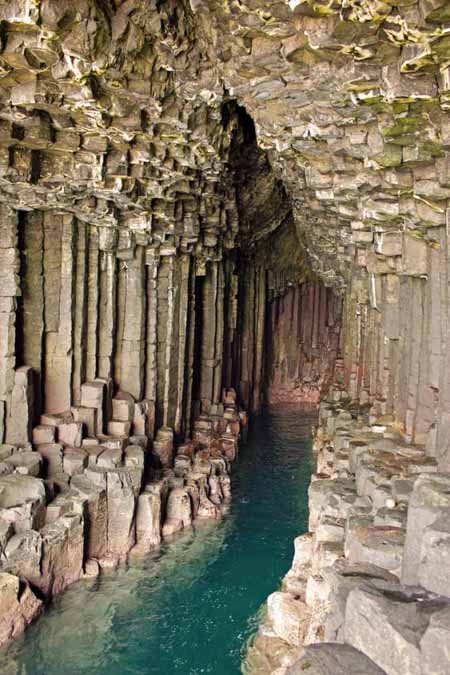
Throughout history, primitive peoples have made use of caves for shelter, burial, or as religious sites. Since items placed in caves are protected from the climate and scavenging animals, which means caves are an archaeological treasure house for learning about indigenous people.
Cave paintings are of particular interest. One example is the Great Cave of Niah, in Malaysia which contains evidence of human habitation dating back 40,000 years. The main cave is one of the largest limestone caves in the world. The cave system is an important prehistorical site with human remains dating to 40,000 years ago. Painted Cave has rock paintings dated at 1200 years. The caves are also well known for the birds' nest collection.
Caves are also important for geological research because they can reveal details of past climactic conditions in speleothems and sediment layers.
The word 'cave' is sometimes a metaphor for the mind, hidden within is sacred knowledge that yearns to be discovered.
Caves around the world contain information in various forms about the ancient history of planet Earth as if markers in time. Hidden within caves we find:
- Chambers
- Tablets - Artifacts - Scrolls - Texts - Crystals
- Paleontology - Evidence and Fossils
- Evidence of Extraterrestrials
- Interdimensional Portals - Indwell and Outwells of Energies - Electromagnetic Energy Vortexes
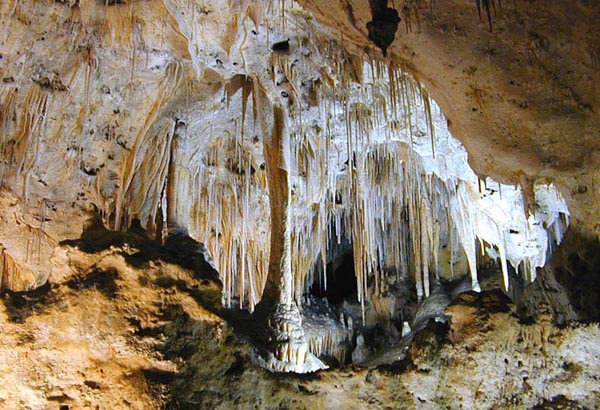
Carlsbad Caverns
Carlsbad Caverns National Park is a United States National Park in the Guadalupe Mountains in southeastern New Mexico. The primary attraction of the park is the show cave, Carlsbad Cavern. The park contains over 117 caves.
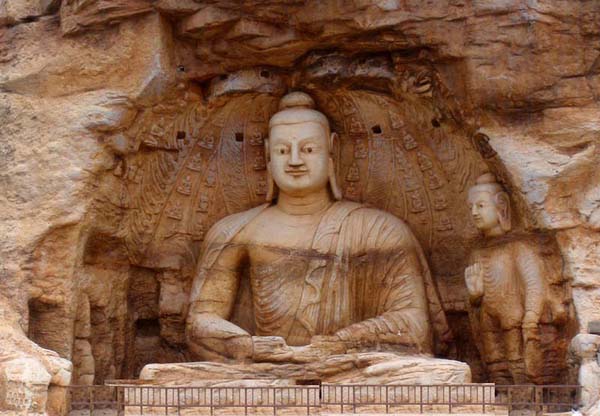
Mogao Caves In China
A Tang Dynasty inscription records that the first cave in the Mogao Grottoes was made in 366 A.D. The United Nations Educational, Scientific and Cultural Organization (UNESCO) listed the Mogao Grottoes on the World Heritage List in 1987. According to archaeologists, it is the greatest and most consummate repository of Buddhist art in the world. Despite erosion and man-made destruction, the 492 caves are well preserved, with frescoes covering an area of 45,000 square metres, more than 2,000 colored sculptured figures and five wooden eaves overhanging the caves.
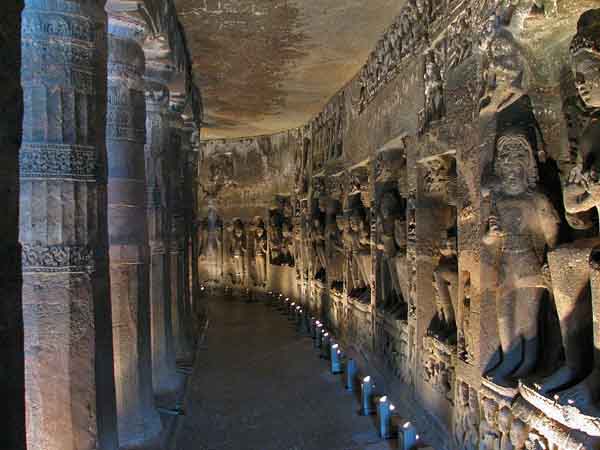
Ajanta Caves in India
The Ajanta Caves in India are 29 rock-cut cave monuments which date from the 2nd century BCE. The caves include paintings and sculptures considered to be masterpieces of both Buddhist religious art (which depict the Jataka tales) as well as frescos which are reminiscent of the Sigiriya paintings in Sri Lanka. The caves were built in two phases starting around 200 BCE, with the second group of caves built around 600 CE.
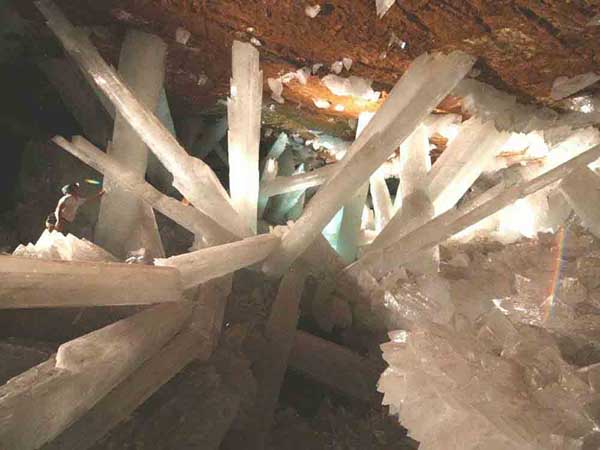
Crystal Cave of Giants in Mexico
The Naica Mine of Chihuahua, Mexico, is a working mine that is known for its extraordinary crystals. Naica is a lead, zinc and silver mine in which large voids have been found, containing crystals of selenite (gypsum) as large as 4 feet in diameter and 50 feet long. The chamber holding these crystals is known as the Crystal Cave of Giants, and is approximately 1000 feet down in the limestone host rock of the mine.
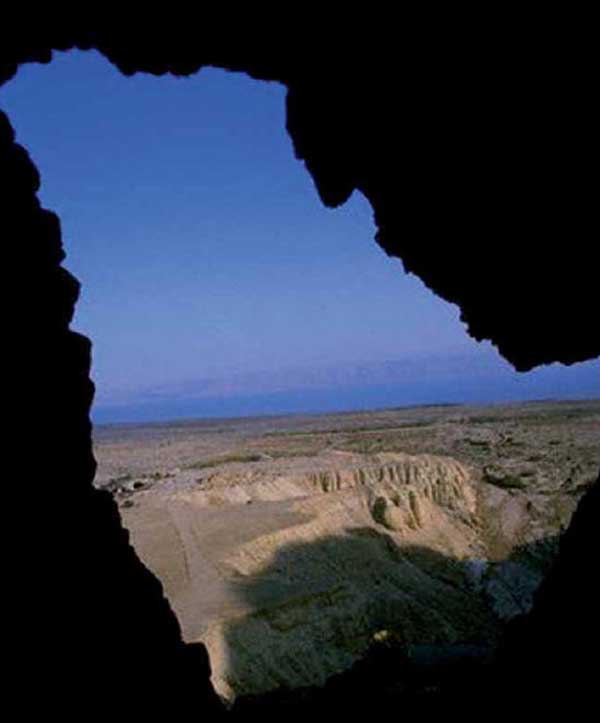
Quamran Caves - Dead Sea Scrolls
northwest shore of the Dead Sea
The settlement of Qumran is 1 km inland from the northwest shore of the Dead Sea. The scrolls were found in eleven caves nearby, between 125m (Cave 4) and 1 km (Cave 1) away. None were found within the settlement, unless it originally encompassed the caves. In the winter of 1946-47, Palestinian Muhammed edh-Dhib and his cousin discovered the caves, and soon afterwards the scrolls.
France
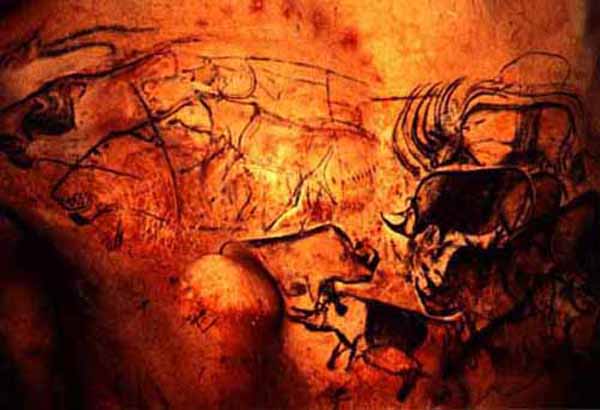
Cave at Lascaux, France Oldest Petroglyphs
Lascaux is a complex of caves in southwestern France famous for its cave paintings. The original caves, located near the village of Montignac. They contain some of the earliest known art, dating back to somewhere between 13,000 and 15,000 BCE, or as far back as 25,000 BCE.
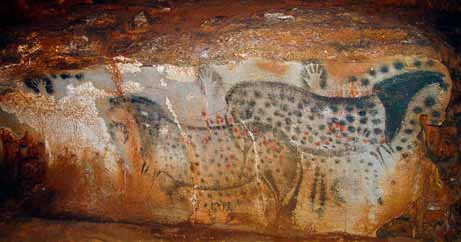
Prehistoric European Cave Artists Were Female
National Geographic - June 26, 2009
Inside France's 25,000-year-old Pech Merle cave,
hand stencils surround the famed "Spotted Horses" mural.
Pech Merle Cave Paintings - Images
Spain
Red dot becomes 'oldest cave art' BBC - June 14, 2012
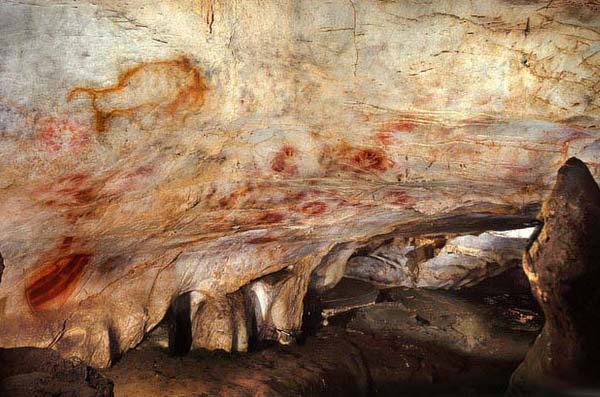
Watch the Video
The El Castillo Cave in Spain -- The refined dating shows these paintings to be far older than anyone thought. Red dots, hand stencils and animal figures represent the oldest examples yet found of cave art in Europe. The symbols on the walls at 11 Spanish locations, including the World Heritage sites of Altamira, El Castillo and Tito Bustillo have long been recognized for their antiquity. But researchers have now used refined dating techniques to get a more accurate determination of their ages. One motif - a faint red dot - is said to be more than 40,000 years old.
-
New dating method shows cave art is older: Did Neanderthals do it? MSNBC - June 14, 2012
When archaeologists tried out a new technique to determine the age of Spain's most famous Paleolithic cave paintings, they were surprised to discover that the paintings were thousands of years older than previously thought - so old that it's conceivable they were painted by Neanderthals. The technique just might change the way we think about the paintings, and the way we think about our long-extinct, long-maligned Neanderthal cousins as well.
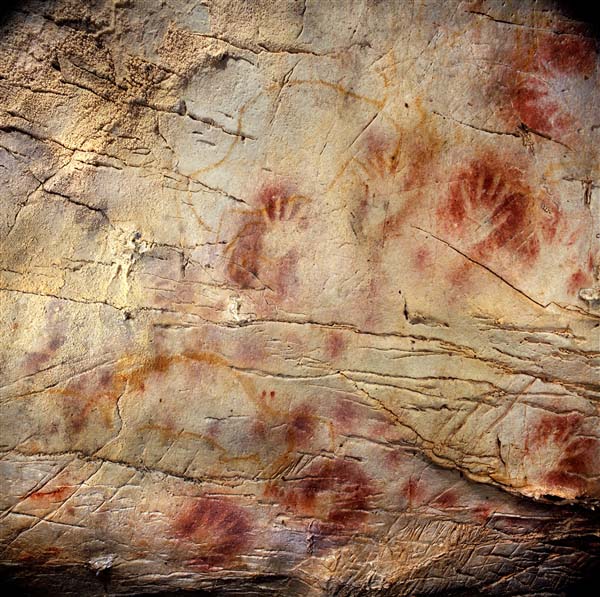
Hand stencils and the outlines of animals dominate "The Panel of Hands" in Spain's El Castillo cave. One of the stencils has been dated to earlier than 37,300 years ago, and a red disk goes back at least 40,800 years, making them the oldest cave paintings in Europe.
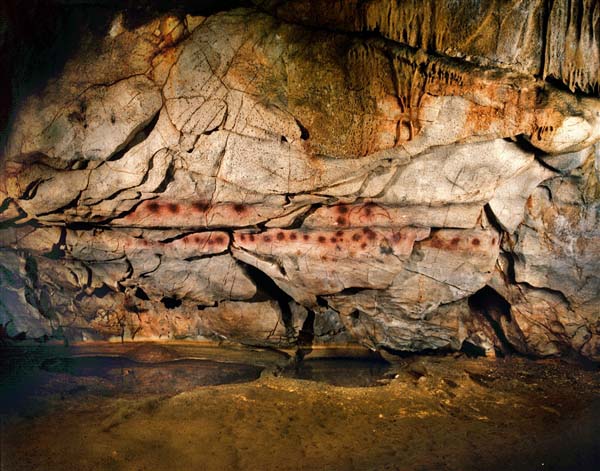
The "Corredor de los Puntos" lies within Spain's El Castillo cave. Red disks here have been dated to between 34,000 and 36,000 years ago, and elsewhere in the cave to 40,800 years ago, making them examples of Europe's earliest cave art.
Germany
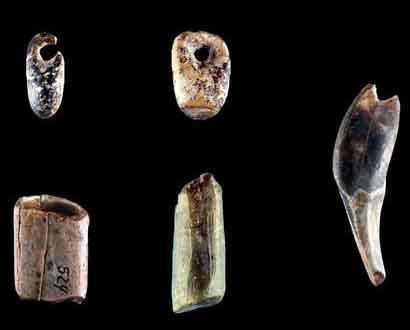
Oldest Art Even Older: New Dates from Geibenklosterle Cave Show Early Arrival of Modern Humans, Art and Music Science Daily - May 24, 2012
Researchers from Oxford and Tubingen have published new radiocarbon dates from the from Geibenklosterle Cave in Swabian Jura of Southwestern Germany in the Journal of Human Evolution. The new dates use improved methods to remove contamination and produced ages between began between 42,000 43,000 years ago for start of the Aurignacian, the first culture to produce a wide range of figurative art, music and other key innovations as postulated in the Kulturpumpe Hypothesis. The full spectrum of these innovations were established in the region no later than 40,000 years ago.
Africa
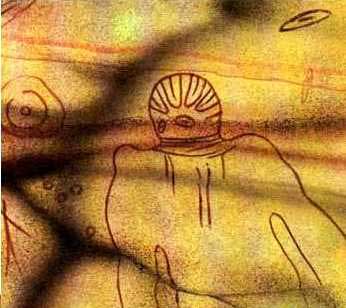
Tassili n'Ajjer, Sahara Desert, North Africa
Sahara rock art is a significant area of archaeological study focusing on the precious treasures carved or painted on the natural rocks found in the central Sahara desert. There are over three thousand sites discovered that have information about Saharan rock art. From the Tibesti massif to the Ahaggar Mountains, the Sahara is an impressive open-air museum containing numerous archaeological sites.
Tassili n'Ajjer (meaning "Plateau of the Rivers") is noted for its prehistoric rock art and other ancient archaeological sites, dating from Neolithic times when the local climate was much moister, with savannah rather than desert. The art depicts herds of cattle, large wild animals including crocodiles, and human activities such as hunting and dancing. The art has strong stylistic links to the pre-Nguni Art of South Africa and the region, executed in caves by the San Peoples before the year 1200 BCE.
The range's exceptional density of rock art paintings-pictograms and engravings-petroglyphs, and the presence of many prehistoric vestiges, are remarkable testimonies to Neolithic prehistory. From 10,000 BCE to the first centuries CE, successive peoples left many archaeological remains, habitations, burial mounds and enclosures which have yielded abundant lithic and ceramic material. However, it is the rock art (engravings and paintings) that have made Tassili world famous as from 1933, the date of its discovery. 15,000 petroglyphs have been identified to date.
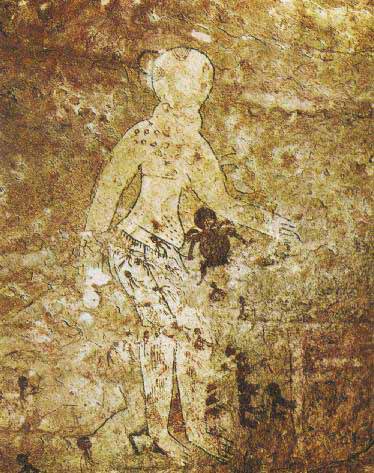
Some of the painting have bizarre depictions of what appear to be spacemen wearing suits, visors, and helmets. resembling modern day astronauts. This takes us to the west African tribe - the Dogon whose legends say they were guided to the area from another part of Africa that was drying up - by fish gods called the Nommo who came in huge ships from the sky.
South Africa
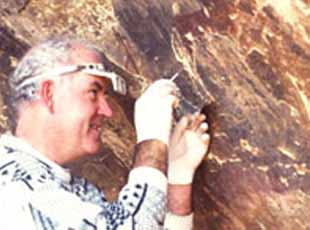
New light shed on South African cave art
BBC - February 7, 2004
A huge collection of rock paintings in South Africa is far older than previously thought, research has found. Archaeologists using the latest radio-carbon dating technology found that the Ukhahlamba-Drakensberg paintings are 3,000 years old. Earlier findings by researchers had indicated that the paintings by San hunters-gatherers were 1,000 years old. The latest research was carried out by the Britain's Newcastle University and Australian National University. There are more than 40,000 rock paintings at the site in South Africa.
Afghanistan
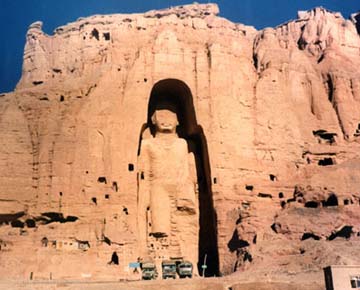
Earliest Oil Paintings Found in Famed Afghan Caves
National Geographic - February 7, 2008
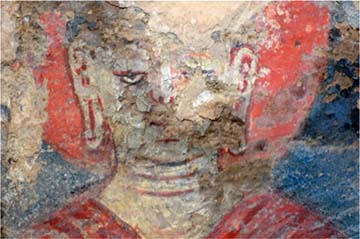
Buddhist murals from Afghanistan's famed Bamiyan caves are the world's earliest known oil paintings, according to a new chemical analysis. (See photos of the paintings and the cliffs that housed them.) The finds, dated to around the 7th century A.D., predate the origins of similar sophisticated painting techniques in medieval Europe and the Mediterranean by more than a hundred years.
Argentina
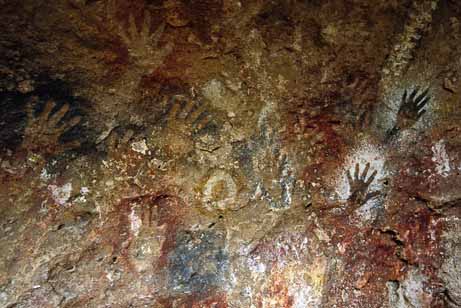
Hand Stencils Through Time National Geographic - June 26, 2009
Clusters of hand stencils dating back 2,500 years cover the walls of
Argentina's Cueva de las Manos -- Cave of the Hands in Patagonia.
Clusters of hand stencils dating back 2,500 years cover the walls of Argentina's Cueva de las Manos in Patagonia. Prehistoric handprints and stencils span all continents and began appearing on rock walls around the world at least 30,000 years ago.
Shanidar Cave in Iraq
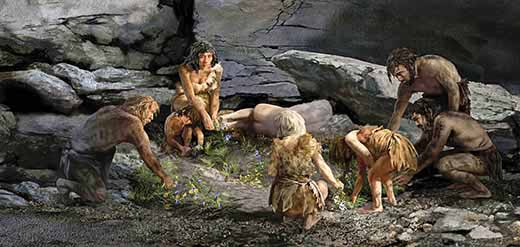
Iraq: The Skeletons of Shanidar Cave Smithsonian - March 2010
1n 1856, laborers working in a limestone quarry in the Neander Valley near Dusseldorf, Germany, dug up some unusual-looking bones. Subsequent study revealed that they belonged to a previously unknown species of humans, similar to, but distinct from our own species, Homo sapiens. The newly discovered hominid was named Neanderthal - thal is Old German for valley - and has fascinated anthropologists ever since.
It was first thought that Neanderthals may have resembled apes - with stooped posture and bent knees - more closely than modern humans. Then, in the 1950s, Smithsonian anthropologist Ralph Solecki, a team from Columbia University and Kurdish workers unearthed the fossilized bones of eight adult and two infant Neanderthal skeletons - spanning burials from 65,000 to 35,000 years ago -at a site known as the Shanidar cave, in the Kurdistan area of northern Iraq. The discovery changed our understanding of Neanderthals.
 Iraq The Hidden Story Google Videos (48:40)
Iraq The Hidden Story Google Videos (48:40)
Cave of Tayos in Ecuador
The Cave of Tayos is a natural cave located on the eastern slopes of the Andes mountains in the Morona-Santiago province of Ecuador.
The cave was popularized by Erich von Daniken's 1973 book The Gold of the Gods, in which he wrote that Juan Moricz had claimed to have explored Cueva de los Tayos in 1969 and discovered mounds of gold, unusual sculptures and a metallic library. These items were said to be located within artificial tunnels that had been created by a lost civilization with help from extraterrestrial beings. Von Daniken had previously stirred public imagination by suggesting that extraterrestrials were involved in ancient civilizations in his popular book Chariots of the Gods.
As a result of the claims published in von Daniken's book, an investigation of Cueva de los Tayos was organized by Stan Hall from Britain in 1976. One of the largest and most expensive cave explorations ever undertaken, the expedition included over a hundred people, including experts in a variety of fields, British and Ecuadorian military personnel, a film crew, and former astronaut Neil Armstrong. The team also included eight experienced British cavers who thoroughly explored the cave and conducted an accurate survey to produce a detailed map of the cave. There was no evidence of Von Daniken's more exotic claims, although some physical features of the cave did approximate his descriptions and some items of zoological, botanical and archaeological interest were found.
In the 20th century, a Roman Catholic missionary named Father Carlo Crespi helped the local Indians, the Shuar culture, who gave him some unique gifts that often took the form of elaborately carved artifacts some made of gold or other precious metals. Many of these artifacts feature elaborate carvings and symbols not know to be associated with the Shuar people. One of the presents was metal tablet with 36 symbols that no one could translate.
In 1991, an Ecuadorian manned named Patronio Jaramillo who claimed to have entered the cave through a secret entrance back in 1946 as a teenage boy. He claimed that he had to dive into the water, swim through an underwater tunnel then came up. He described wandering through chamber after chamber of ancient relics, including a vast room of books made from gold and other metals - books with unrecognizable writing possibly like those in Father Crespi's collection - symbols of unknown origin. Jaramillo died before he could show anyone where the cave was located.
Underground World of Xibalba
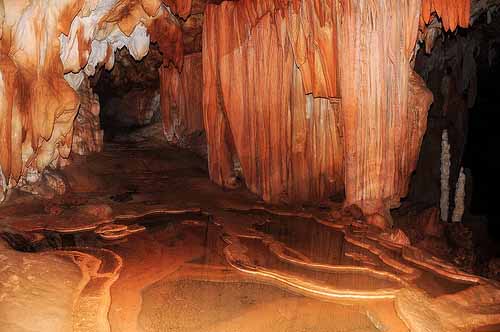
Xibalba, roughly translated as "place of fear", is the name of the underworld in Maya mythology, ruled by the Maya death gods and their helpers. In 16th-century Verapaz, the entrance to Xibalba was traditionally held to be a cave in the vicinity of Coban, Guatemala. According to some of the K'iche' Maya presently living in the vicinity, the area is still associated with death. Cave systems in nearby Belize have also been referred to as the entrance to Xibalba. Another physical incarnation of the road to Xibalba as viewed by the K'iche' is the dark rift which is visible in the Milky Way.

Blue Holes
WikipediaA blue hole is a cave (inland) or underwater sinkhole. They are also called vertical caves. There are many different blue holes located around the world, typically in low-lying coastal regions. The best known examples can be found in Belize, the Bahamas, Guam, Australia (in the Great Barrier Reef), and Egypt (in the Red Sea).
Life Beyond Earth? Underwater Caves in Bahamas Could Give Clues Science Daily - January 27, 2012
Discoveries made in some underwater caves by Texas &M University at Galveston researchers in the Bahamas could provide clues about how ocean life formed on Earth millions of years ago, and perhaps give hints of what types of marine life could be found on distant planets and moons. Tom Iliffe, professor of marine biology at the Texas A&M-Galveston campus, and graduate student Brett Gonzalez of Trabuco Canyon, Calif., examined three "blue holes" in the Bahamas and found that layers of bacterial microbes exists in all three, but each cave had specialized forms of such life and at different depths, suggesting that microbial life in such caves is continually adapting to changes in available light, water chemistry and food sources. "Blue holes" are so named because from an aerial view, they appear circular in shape with different shades of blue in and around their entrances. There are estimated to be more than 1,000 such caves in the Bahamas, the largest concentration of blue holes in the world.
In the News ...
Killer Cave May Have Inspired Myth of Hades Live Science - November 29, 2012
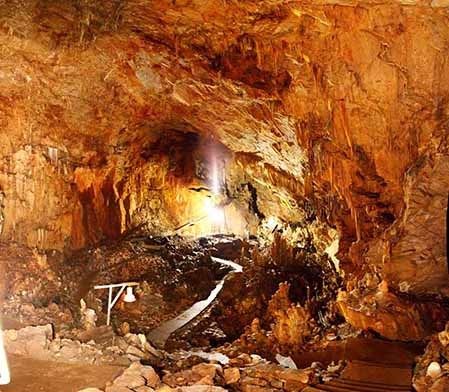
A giant cave that might have helped serve as the inspiration for the mythic ancient Greek underworld Hades once housed hundreds of people, potentially making it one of the oldest and most important prehistoric villages in Europe before it collapsed and killed everyone inside, researchers say. The complex settlement seen in this cave suggests, along with other sites from about the same time, that early prehistoric Europe may have been more complex than previously thought. The cave, located in southern Greece and discovered in 1958, is called Alepotrypa, which means "foxhole."
Caves Reveal Picture of Ancient Winters Live Science - November 29, 2012
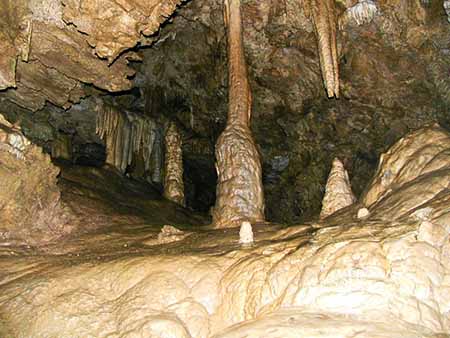
Scientists have found a stalagmite in an Oregon cave that tells the story of thousands of winters in the Pacific Northwest. Most other ways of estimating past climate, like tree ring data, only tell us about summers, when plants are growing. But understanding ancient winters is also important for regions like western North America, where chilly conditions are critical for determining water resources. For their study, Ersek and his colleagues examined a stalagmite that started forming 13,000 years ago in a cavern in what is now Oregon Caves National Monument. During the region's damp winters, water from the ground seeped through the cave's ceiling and trickled onto the floor, with the drips slowly forming the stalagmite over time.
8 Amazing Caves Around the World Live Science - October 6, 2010
Photos and Text
Dominican Republic: Clues to Caribbean's earliest inhabitants PhysOrg - August 18, 2009
A prehistoric water-filled cave in the Dominican Republic has become a "treasure trove" with the announcement by Indiana University archaeologists of the discovery of stone tools, a small primate skull in remarkable condition, and the claws, jawbone and other bones of several species of sloths. Stone tools, rare animal bones discovered -- clues to Caribbean's earliest inhabitants
World's Biggest Cave Found in Vietnam National Geographic - July 24, 2009
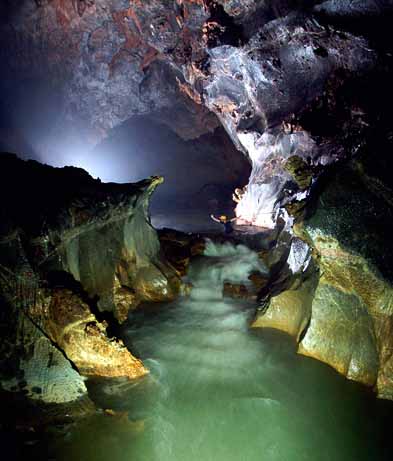
A British caver wades through Vietnam's Son Doong cave, Earth's largest known cave passage, according to a survey team. A massive cave recently uncovered in a remote Vietnamese jungle is the largest single cave passage yet found, a new survey shows. At 262-by-262 feet (80-by-80 meters) in most places, the Son Doong cave beats out the previous world-record holder, Deer Cave in the Malaysian section of the island of Borneo. Deer Cave is no less than 300-by-300 feet (91-by-91 meters), but it's only about a mile (1.6 kilometers) long. By contrast, explorers walked 2.8 miles (4.5 kilometers) into Son Doong, in Phong Nha-Ke Bang National Park, before being blocked by seasonal floodwaters - and they think that the passage is even longer. In addition, for a couple of miles Son Doong reaches more than 460-by-460 feet (140-by-140 meters), said Adam Spillane, a member of the British Cave Research Association expedition that explored the massive cavern. Spillane was in the first of two groups to enter the cave. His team followed the passage as far as a 46-foot-high (14-meter-high) wall.
Australia: Cave Painting Depicts Extinct Marsupial Lion Live Science - May 11, 2009
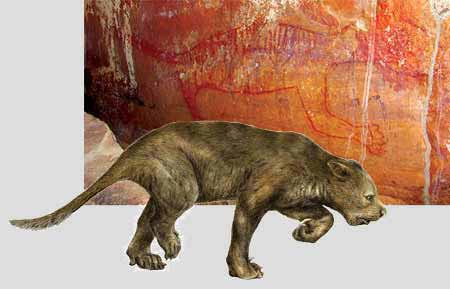
Modern Australia lacks big land predators, but until about 30,000 years ago, the continent was ruled by Thylacoleo carnifex, the marsupial "lion." Several well-preserved skeletons of the leopard-size beast have been found. Now, a newly discovered cave painting offers a glimpse of the animal's external appearance.
Hawaiian Makauwahi Cave Reveals Ancient Secrets National Geographic - October 25, 2008
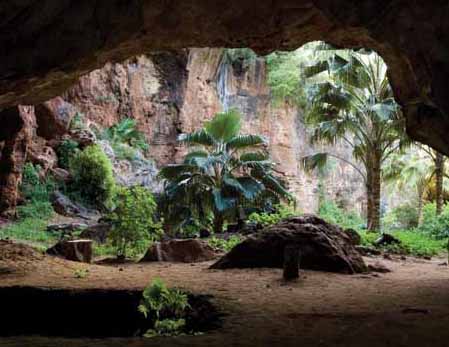
This may be the richest fossil site in the entire Pacific Island region, loaded with bird and fish bones and ancient Polynesian artifacts
Gigantic River Cave Revealed in Laos National Geographic - October 20, 2008
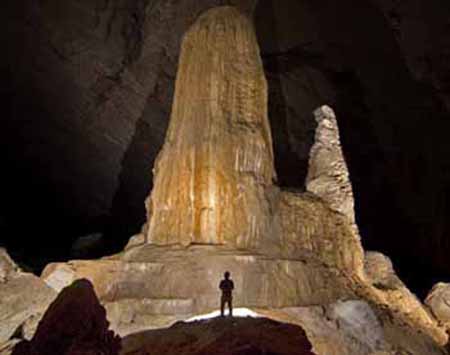
A cave explorer stands before an imposing stalagmite made of mineral deposits near an entrance to the Xe Bang Fai River cave in central Laos. An expedition in February 2008, co-led by veteran caver John Pollack, comprehensively mapped and photographed the 5.9-mile (9.5-kilometer) length of the little-known cavern for the first time.
Oldest Skeleton in Americas Found in Underwater Cave? National Geographic - September 3, 2008
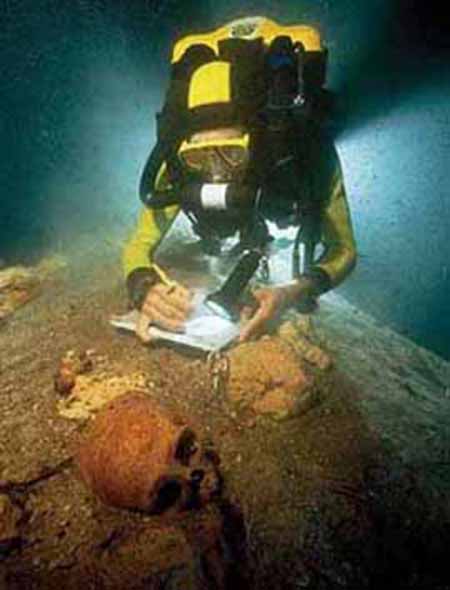
A labyrinth filled with stone temples and pyramids in 14 caves - some underwater - have been uncovered on Mexico's Yucatan Peninsula, archaeologists announced last week. The discovery has experts wondering whether Maya legend inspired the construction of the underground complex - or vice versa.
Portal to Maya Underworld Found in Mexico? National Geographic - August 22, 2008
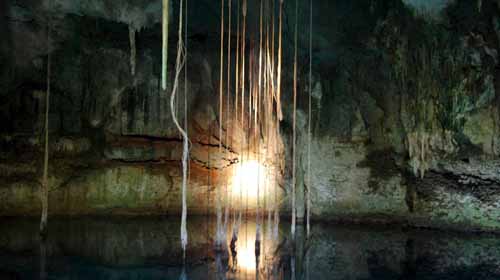
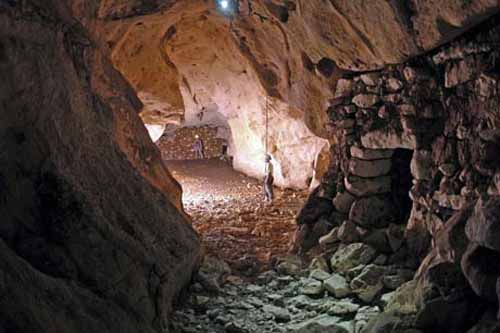
Mexican archeologists have discovered a maze of stone temples in underground caves, some submerged in water and containing human bones, which ancient Mayans believed was a portal where dead souls entered the underworld.
Clad in scuba gear and edging through narrow tunnels, researchers discovered the stone ruins of eleven sacred temples and what could be the remains of human sacrifices at the site in the Yucatan Peninsula.
Archeologists say Mayans believed the underground complex of water-filled caves leading into dry chambers -- including an underground road stretching some 330 feet -- was the path to a mythical underworld, known as Xibalba.
According to an ancient Mayan scripture, the Popol Vuh, the route was filled with obstacles, including rivers filled with scorpions, blood and pus and houses shrouded in darkness or swarming with shrieking bats, Guillermo de Anda, one of the lead investigators at the site. "The souls of the dead followed a mythical dog who could see at night," de Anda said.
Excavations over the past five months in the Yucatan caves revealed stone carvings and pottery left for the dead. "They believed that this place was the entrance to Xibalba. That is why we have found the offerings there," de Anda said. The Mayans built soaring pyramids and elaborate palaces in Central America and southern Mexico before mysteriously abandoning their cities around 900 A.D. They described the torturous journey to Xibalba in the Popul Vuh sacred text, originally written in hieroglyphic script on long scrolls and later transcribed by Spanish conquerors. "It is very likely this area was protected as a sacred depository for the dead or for the passage of their souls," said de Anda, whose team has found ceramic offerings along with bones in some temples.
Different Mayan groups who inhabited southern Mexico and northern Guatemala and Belize had their own entrances to the underworld which archeologists have discovered at other sites, almost always in cave systems buried deep in the jungle. In the Yucatan site they have found one 1,900-year-old ceramic vase, but most of the artifacts date back to between 700 and 850 A.D. "These sacred tunnels and caves were natural temples and annexes to temples on the surface," said de Anda.
Chile: Incredible Discoveries Made in Remote Caves Live Science - July 31, 2008
Scientists exploring caves in the bone-dry and mostly barren Atacama Desert in Chile stumbled upon a totally unexpected discovery this week: water. They also found hundreds of thousands of animal bones in a cave, possibly evidence of some prehistoric human activity. The findings are preliminary and have not been analyzed.
Cavers Chart "Snowy" Crystal River in New Mexico National Geographic - July 24, 2008
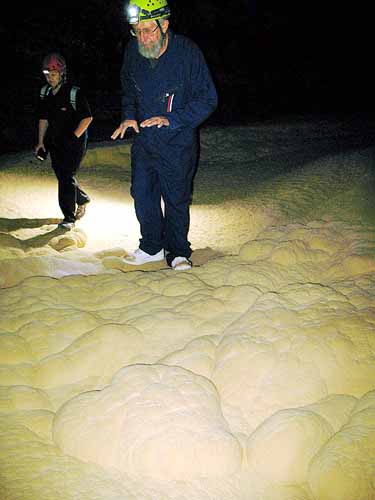
John McLean and a fellow caver walk along a massive mineral formation in Fort Stanton Cave in southwestern New Mexico during an expedition in early July. The odd formation called Snowy River is actually an intricate crust of tiny calcite crystals and spans a distance of at least four miles (six kilometers), although the exact length is still unknown. The surveyors from the Fort Stanton Cave Study Project added several thousand feet to the measurement.
 Lebanon Caves a New Wonder? National Geographic - July 3, 2008
Lebanon Caves a New Wonder? National Geographic - July 3, 2008
Stone Age Art Caves May Have Been Concert Halls National Geographic - July 3, 2008
Prehistoric peoples chose places of natural resonant sound to draw their famed cave sketches, according to new analyses of paleolithic caves in France. In at least ten locations, drawings of horses, bison, and mammoths seem to match locations that focus, amplify, and transform the sounds of human voices and musical instruments.
Cave Men Loved to Sing Live Science - July 3, 2008
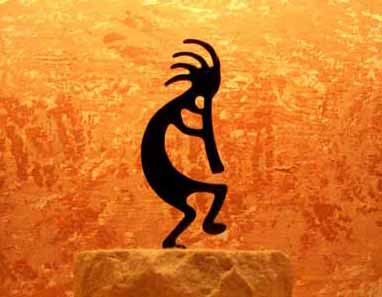
Ancient hunters painted the sections of their cave dwellings where singing, humming and music sounded best, a new study suggests. Analyzing the famous, ochre-splashed cave walls of France, the most densely painted areas were also those with the best acoustics, the scientists found. Humming into some bends in the wall even produced sounds mimicking the animals painted there. The Upper Paleolithic people responsible for the paintings had likely fine-tuned their hearing to recognize the sound qualities in certain parts of the cave and chose to do their artwork there as a kind of landmark, perhaps as part of a singing ritual
Earliest Oil Paintings Discovered Live Science - April 22, 2008
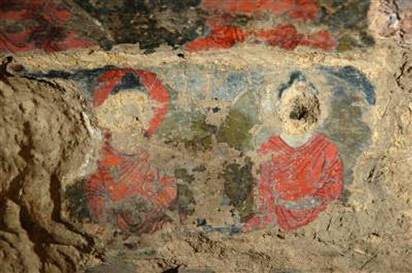
Oil paintings have been found in caves behind the two ancient colossal Buddha statues destroyed in 2001 by the Taliban, suggesting that Asians - not Europeans - were the first to invent oil painting
Florida: Divers Break Record for Longest Cave Passage National Geographic - December 17, 2007
Completing the longest dive from one cave opening to another, divers on a
treacherous 20-hour journey proved that vast underwater networks in Florida are linked.
Found! World's oldest caves News in Science - July 26, 2006
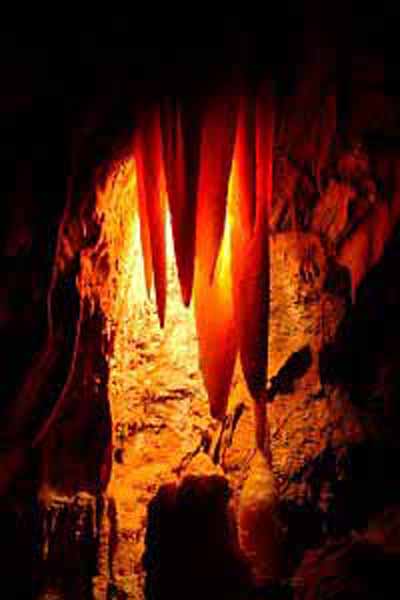
The Jenolan caves west of Sydney date back some 340 million years, making
them the oldest known open caves in the world, Australian geologists say. The oldest previous dating for an open cave was around 90 million years. In geological terms, 340 million years is a very long time. To put it into context, the Blue Mountains began to form 100 million years ago; dinosaurs became extinct 65 million years ago, and Tasmania was joined to the mainland as recently as 10,000 years ago. The discovery opens the possibility that there could be evidence of other ancient geological events in the caves that scientists haven't looked for yet. For example, the researchers think the clay in the cave was formed when volcanic ash entered.
Jenolan Caves
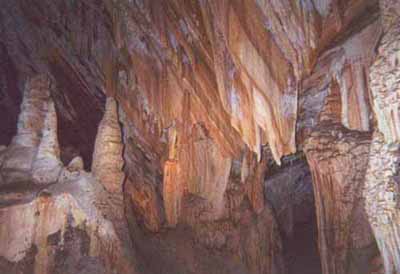
Ancient cave in western France contains rare finds, experts announce PhysOrg - June 3, 2006
A 27,000-year-old human skeleton laid out in a room decorated
with ancient art was among the rare finds at a cave in western France
whose subterranean art predates that of the famed Lascaux caves.
Explorers Discover Huge Cave and New Poison Frogs Live Science - February 21, 2006
Actually, "Cueva del Fantasma" - Spanish for "Cave of the Ghost" - is so vast that
two helicopters can comfortably fly into it and land next to a towering waterfall.
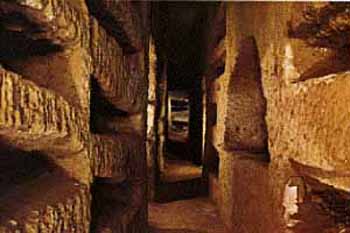
Catacomb Find Boosts Early Christian-Jewish Ties National Geographic - July 20, 2005
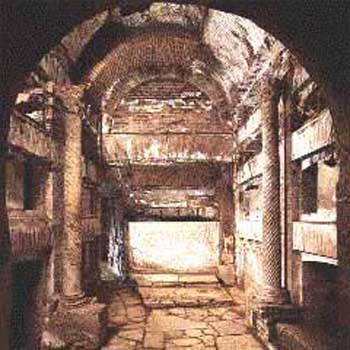
The word catacomb comes from Greek kata kumbas (L. ad catacumbas), "near the low place" and originally it meant a certain burial district in Rome. It can refer to any network of caves, grottos, or subterranean place that is used for the burial of the dead, or it can refer to a specific underground burial place.
There are also catacomb-like burial chambers in Anatolia, Turkey; in Susa, North Africa; in Naples, Italy; in Syracuse, Italy; Trier, Germany; Kiev, Ukraine. Capuchin catacombs of Palermo, Sicily were used as late as 1920s.
In Ukraine and Russia, catacomb (used in the local languages' plural katakomby) also refers to the network of abandoned caves and tunnels earlier used to mine stone, especially limestone. Such catacombs are situated in Crimea and the Black Sea coast of these two countries. The most famous are catacombs beneath Odessa and Ajimushkay, Crimea, Ukraine. They served as bases for Soviet World War II guerillas. Ajimushkay catacombs hosted about 10.000 fighters and refugees. Many of them died and were buried there, and memorials and museums were later established (it is now a territory of Kerch city). Read More
Cavers smash world depth record BBC - April 2005
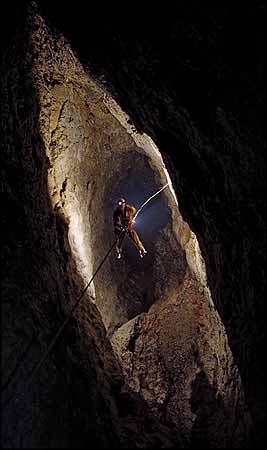
Cavers have ventured deeper into the Earth than anyone
has been before at Krubera, the world's deepest known cave.
Israeli cave linked to John the Baptist MSNBC - August 16, 2004
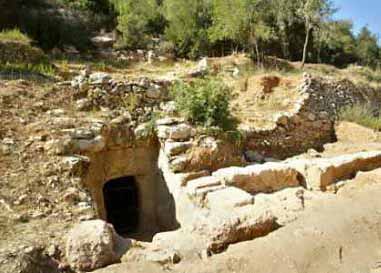
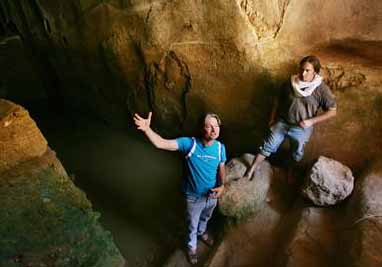
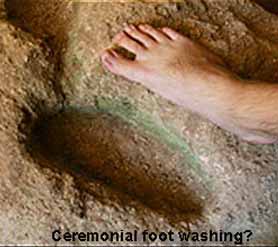
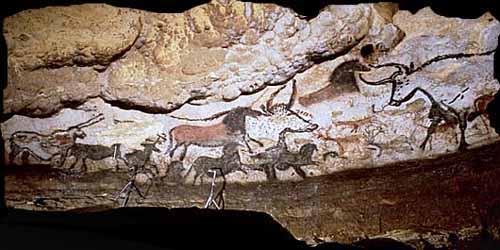
Petroglyphs - Pictographs - Cave Paintings

Access to Subterranean Civilizations